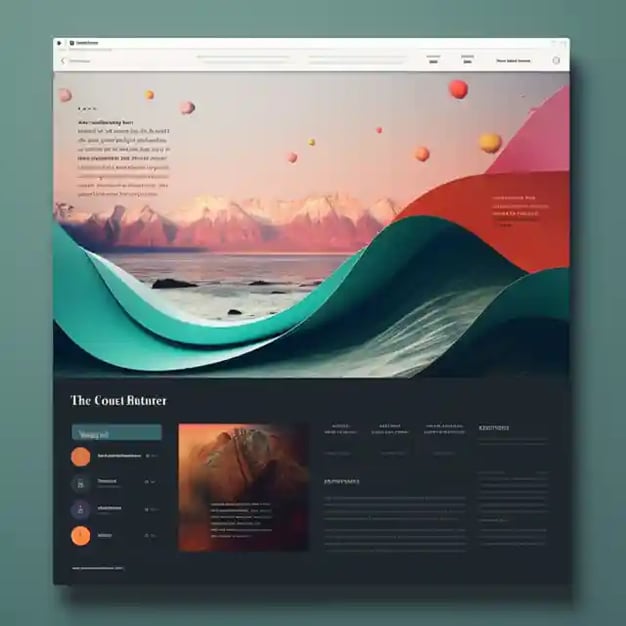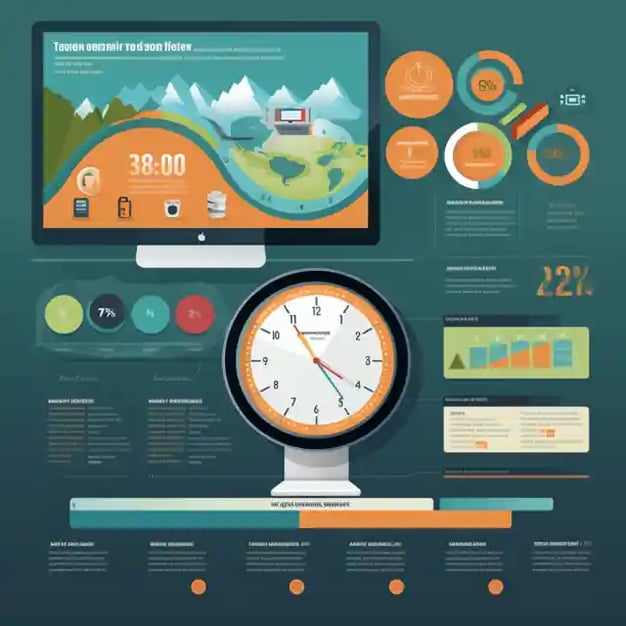Enhancing User Engagement with Google Page Experience
- Home
- Enhancing User Engagement with Google Page Experience
Google Page Experience is a game-changer in the digital landscape and ever-changing world of SEO services. This new ranking algorithm from Google has redefined how websites are evaluated and ranked.
User experience is now at the forefront of website evaluation and ranking, rather than just content quality. The better your site's user experience, the higher it can potentially rank.
In essence, Google Page Experience has made UX design an integral part of SEO strategy. It’s time to take notice!
Table of Contents:
- Decoding Core Web Vitals as Essential Metrics
- Emphasising Mobile-friendly Design for Optimal User Engagement
- Navigating Towards Mobile-first Indexing
- Optimising Above-the-fold Content For Improved User Interaction
- FAQs in Relation to Google Page Experience
- Conclusion

Decoding Core Web Vitals as Essential Metrics
In the quest to provide an outstanding user experience, Google introduced a concept known as Core Web Vitals. These metrics are instrumental in understanding and improving your website's performance.
The three key components of these vitals include Largest Contentful Paint (LCP), Cumulative Layout Shift (CLS), and First Input Delay (FID). Each metric evaluates different aspects such as loading speed, visual stability, and interactivity, respectively.
Digging Deeper into the Largest Contentful Paint
The largest Contentful Paint or LCP is a crucial component that measures perceived load speed. It identifies when the primary content on your page becomes visible to users during the initial loading phase. A good LCP score can make all the difference between retaining visitors or losing them due to slow site speeds.
To achieve optimal results with this metric, aim for an LCP score under 2.5 seconds from when your page begins loading. This ensures users get access quickly to their desired information, which enhances overall browsing satisfaction levels significantly.
Improving server response times using HTTP caching, route-based code splitting, and rendering critical path CSS inline while deferring non-critical JS/CSS files are some effective strategies you can employ towards achieving better scores here.
Analysing Visual Stability With Cumulative Layout Shift
Cumulative Layout Shift or CLS provides insights about how often unexpected layout shifts occur on your webpage - elements moving around unexpectedly could lead to bad user experiences causing frustration among viewers hence lowering engagement rates over time. The ideal goal would be maintaining less than 0.1 shift per session ensuring minimal disruptions during the navigation process thus creating a smoother online journey throughout the visitation period.
Avoiding the addition of new content above existing ones unless triggered by user action like clicking a button/link; reserving space for ad slots; sizing media elements properly before upload so the browser knows exactly where each element fits within the layout structure these steps help prevent re-layouts after the initial paint phase ends, thereby reducing instances of CLS and improving the overall user experience.
Google's Core Web Vitals, including Largest Contentful Paint (LCP), Cumulative Layout Shift (CLS), and First Input Delay (FID) are key to enhancing your website's performance. Aim for an LCP score under 2.5 seconds, maintain a CLS of less than 0.1 per session, and optimize server response times for better
Emphasizing Mobile-friendly Design for Optimal User Engagement
The growth of handheld gadgets has altered the digital landscape. Today, a website that isn't optimised for mobile use is at risk of falling behind in Google's search results. This shift towards prioritising user experience on mobile platforms is part and parcel of Google's core ranking systems.
A mobile-optimised site not only enhances the overall page experience users feel but also boosts your visibility online. Since 2015 when Google announced its "Mobilegeddon" update, sites designed to be friendly to smartphone and tablet users have seen an improvement in their SERP rankings.

Prioritising Responsive Web Design
In today's world where different screen sizes abound from smartphones to tablets and desktops, responsive web design (RWD) plays a crucial role in providing an optimal viewing experience across all these devices. It addresses issues such as small text size or difficult navigation which often lead to bad user experiences, especially on non-responsive designs.
Beyond just improving how visitors interact with your pages, RWD offers several SEO benefits including:
- Faster Load Times: A well-implemented responsive design can significantly improve load times, particularly over slower networks commonly used by mobile devices.
- No Duplicate Content Issues: RWD eliminates potential duplicate content problems associated with maintaining separate versions for desktop & mobile - something that could harm SEO efforts otherwise.
- Easier Site Management: Maintaining one version makes it easier to manage updates effectively, thus saving time and resources better spent elsewhere within business operations.
Navigating Towards Mobile-first Indexing
To provide outstanding content regardless of the device type being used to access it, Google introduced 'Mobile-first indexing', meaning it predominantly uses the webpage's contents to index and rank purposes rather than relying solely upon those created specifically for larger screens like before. With this change looming on the horizon, make sure you are prepared to avoid any negative impacts that might occur once it fully rolls out. Update your content strategy to prioritize mobile-friendly formats and continuously monitor performance across various devices.
Don't let your website fall behind in the digital race. Embrace mobile-friendly design and responsive web design for optimal user engagement, improved visibility online, and better SEO. Remember, Google is all about 'Mobile-first indexing' now - be prepared or risk being left in the dust.
Optimising Above-the-fold Content For Improved User Interaction
The first glimpse users get of your website is the above-the-fold content. It's a crucial element in user engagement and can significantly influence core web vital metrics.
Tips To Improve Above-The-Fold Content Optimisation
To enhance the experience users feel when they visit your site, optimising this critical section should be part of your strategy. Here are some actionable tips:
- Strategic Placement and Sizing Media Files: Your media files' placement and size play a significant role in load times, which directly affect Largest Contentful Paint (LCP), one of Google's core ranking systems that measure perceived load speed. Therefore, it's essential to strategically place appropriately sized images for different devices while avoiding large media files that could slow down page loading time.
- Limited Use Of Custom Fonts: Aesthetically pleasing custom fonts may negatively impact site speed if not optimised properly - another factor influencing LCP scores as per Google's announced updates on Core Web Vitals. By limiting their usage within the above-the-fold content, you improve page loading performance without compromising design appeal.
- Prioritise Important Information: Create an immediate connection with visitors by prioritising key messages about your brand or business offerings within this space. This ensures visitors quickly understand what you offer before deciding whether to continue exploring further down the page.
Beyond these technical aspects, remember that providing outstanding content remains paramount regardless of where it sits on the webpage. As reiterated by experts from Google Search Central Blog, "Great Page Experience doesn't override having great relevant content". So even while focusing optimisation efforts towards improving technical elements like LCP score, don't lose sight of ensuring relevance and quality in every piece of written material shared online through building engaging and meaningful narratives around the products and services offered by the company.

Maintaining Balance Between Design And Performance
Finding a balance between creating visually appealing designs while ensuring optimal performance might seem challenging but isn't impossible to achieve provided you align design principles with performance metrics. Utilize modern technologies and design methodologies that allow for dynamic rendering and efficient loading while maintaining aesthetic integrity.
Mastering your website's above-the-fold content is key to user engagement. Strategic media placement, limiting custom fonts, and prioritising crucial info can boost load times and Google's LCP scores. But remember - a slick design won't save poor content.
FAQs about Google Page Experience
What is Google's page experience?
Google's page experience refers to a set of signals that measure how users perceive the interaction with a web page beyond its pure information value.
What impacts the Google page rank?
A variety of factors impact Google Page Rank, including site speed, mobile-friendliness, security (HTTPS), and user-centric metrics known as Core Web Vitals.
What is the Google Page Experience update?
The Google Page Experience update is an algorithm change aimed at prioritising websites offering high-quality user experiences in search engine results pages (SERPs).
What is the Google ranking of pages?
Google ranking refers to the position that your website appears in the SERPs for specific search terms. Higher rankings are influenced by SEO optimisation and quality content among other factors.
Conclusion
Google's algorithm evolution has made user experience a priority. The importance of conversational search and mobile-friendliness cannot be overstated.
Intrusive pop-ups can negatively impact the page experience, especially for mobile users.
The core web vitals are key metrics that assess loading performance and visual stability.
A secure site with HTTPS not only protects data but also boosts SERP rankings.
Mobile-friendly design is crucial for optimal user engagement. It's all about responsive design now!
Above-the-fold content optimisation plays a significant role in improving core web vital scores and enhancing user interaction.
Avoiding negative impacts on your website's performance can significantly improve both user engagement & overall SEO rankings. Be aware of potential threats!
If you're ready to enhance your website's Google Page Experience score, consider working with us at Whitehat. We specialize in inbound marketing strategies that focus on creating quality content while optimising the overall page experience for users. Join us today, let's elevate your online presence together!





